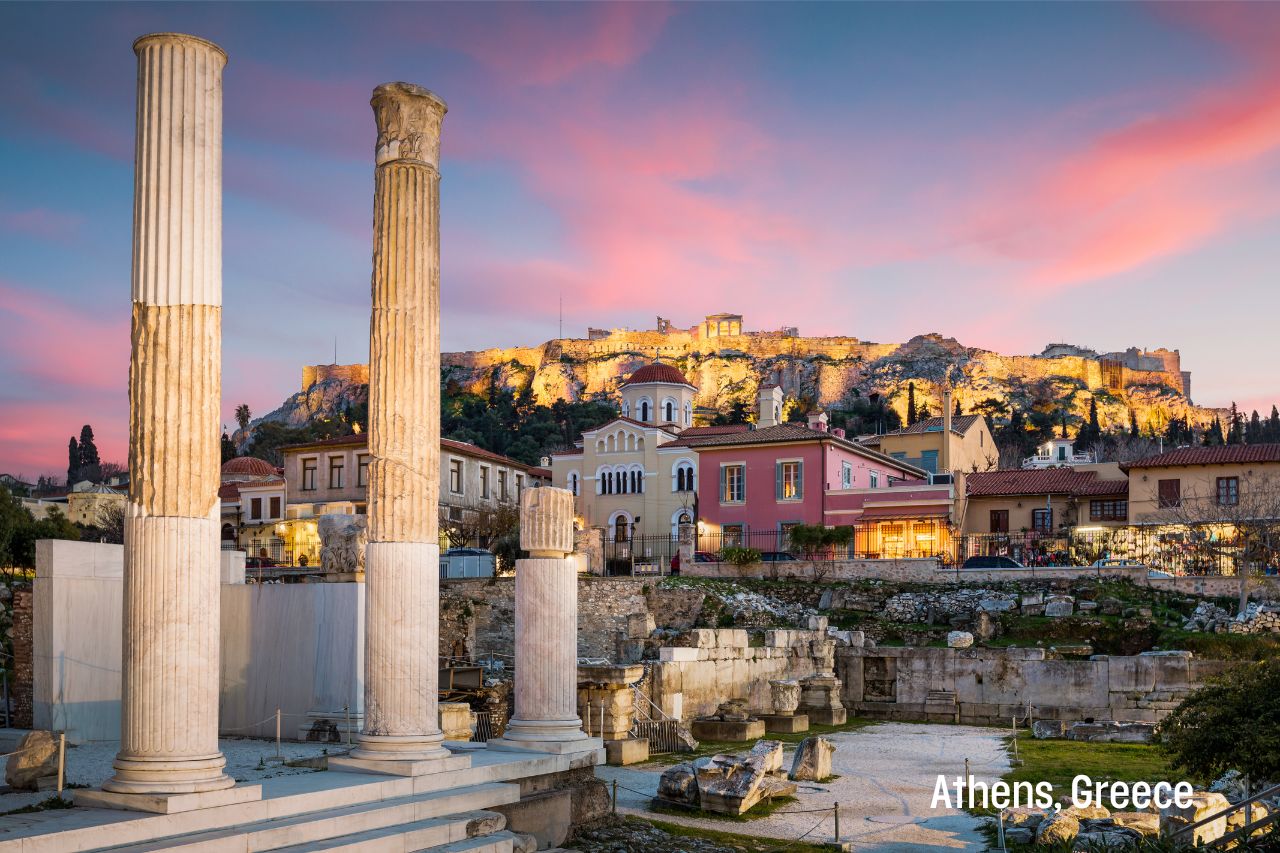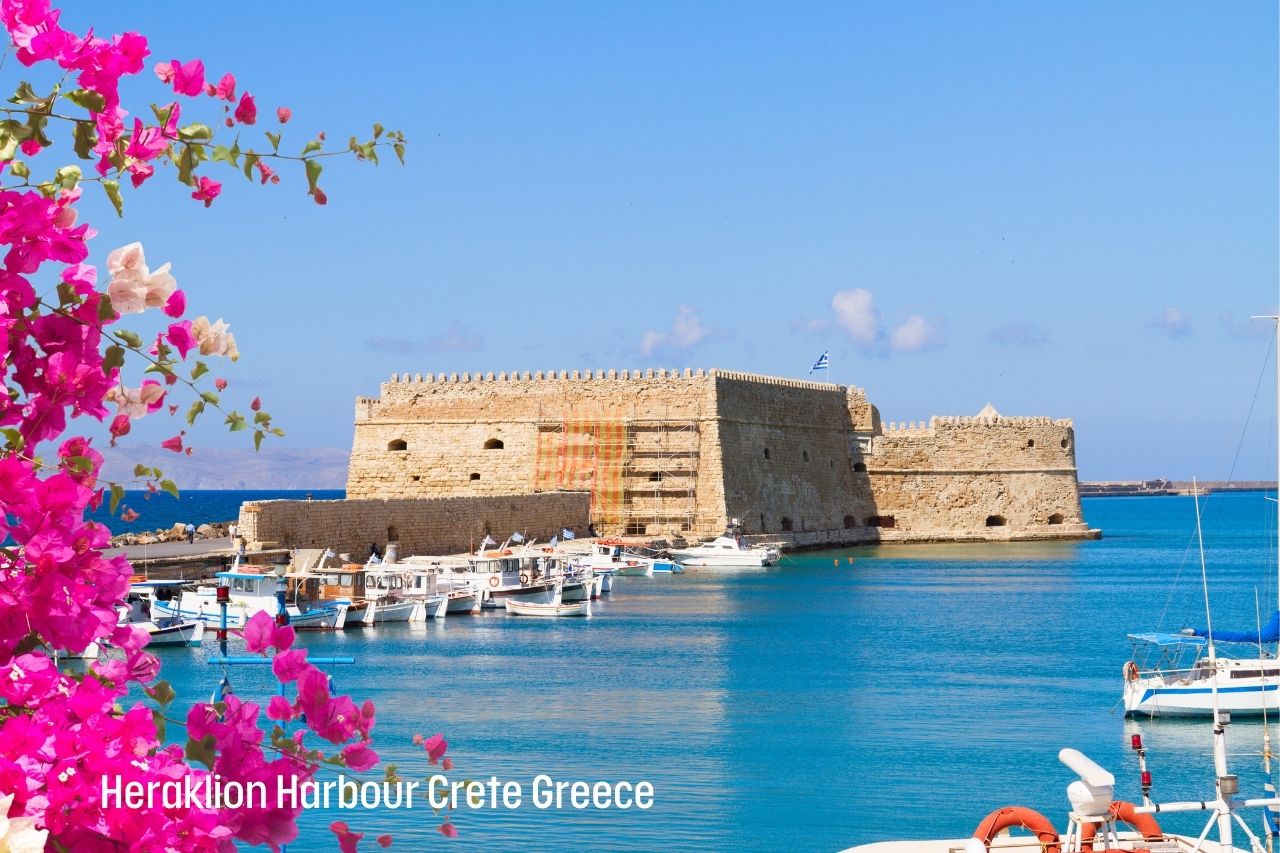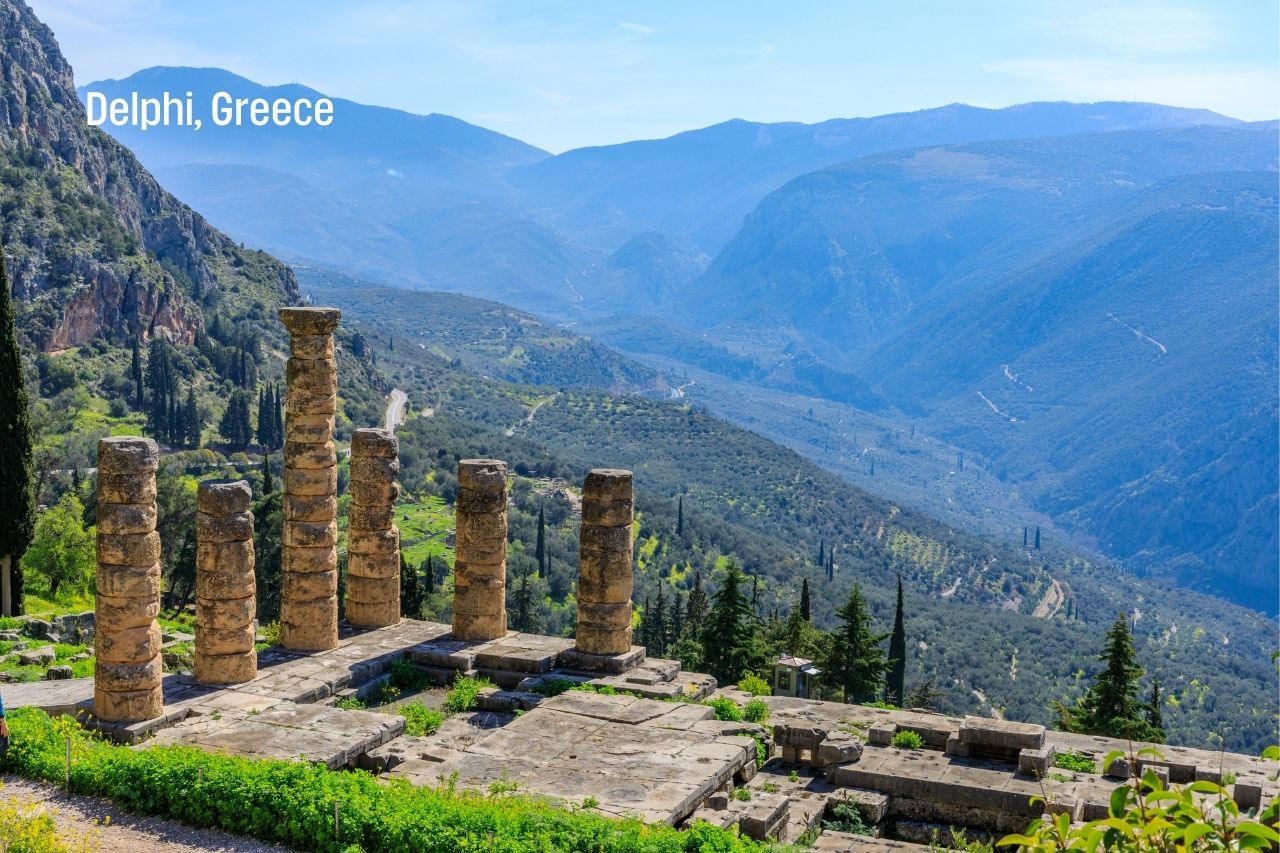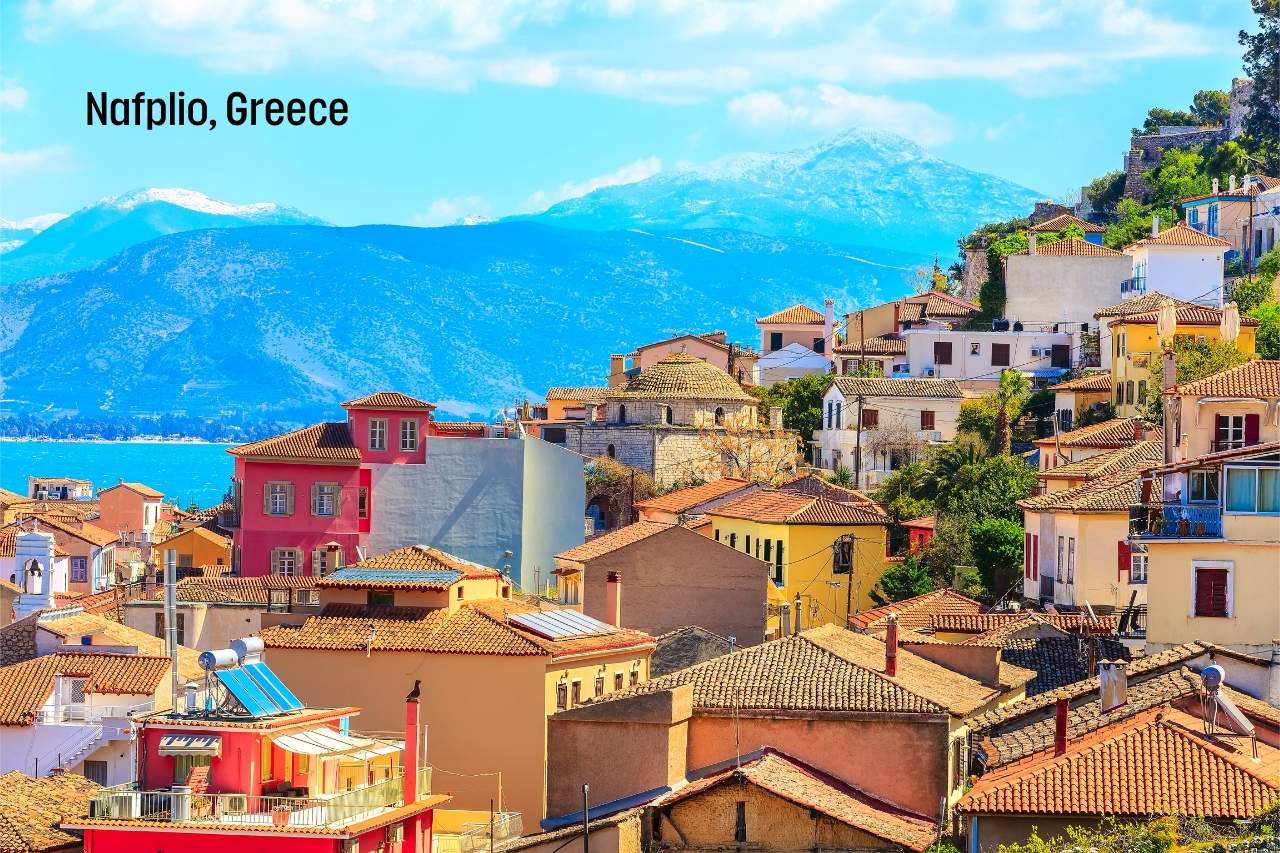Greece is renowned for its stunning natural surroundings and enthralling culture. It is home to some of the most significant historical sites in the world as well as almost 6,000 islands. Greece is one of the most popular tourist destinations in Europe because of its historic archeological monuments, sand and pebble beaches, cliffs plunging into glistening blue ocean, and pleasant Mediterranean weather.
Athens
One of Europe’s most captivating capital cities, Athens blends historical treasures with a contemporary vibrancy, spanning millennia of history. Discover the Acropolis and Temple of Olympian Zeus during the day, and then immerse yourself in Plaka’s dining and drinking culture at night. You’ll never be bored in the Cradle of Western Civilization.

Acropolis
- Address: Athens 105 58, Greece
- Opening hours: 08:00 – 20:00
- Entrance fee: €10
There aren’t many places on Earth like the Acropolis in Athens, where the Parthenon temple is poised atop a granite cliff, overlooking centuries of civilization. The Acropolis, situated on a fortified hill, served as the hub of the ancient city and a symbol of the splendor of Athens.
The most famous structure is the Parthenon, which dates from 447 BC to 338 BC and was the biggest temple in classical antiquity. The temple’s imposing rows of Doric columns and exquisite sculpture elements make it a sight to see. The goddess Athena’s birth is shown in reliefs on the frieze on the eastern wall.
The Temple of Athena Nike near the Acropolis’ entrance and the Erechtheion, a collection of historic sanctuaries constructed between 421 and 395 BC, are two further sites of historical significance. The Porch of the Caryatids, which has six sculptures of maidens in place of Doric columns, is the most well-known aspect of the Erechtheion complex.
Acropolis Museum
- Address: Dionysiou Areopagitou 15, Athina 117 42, Greece
- Opening hours: 09:00 – 17:00
- Entrance fee: €10 for permanent exhibition/ temporary exhibition
One of the most significant collections of ancient Greek art in the world may be seen in the Acropolis Museum, another of Athens’ main attractions. The old museum on the hill was replaced with the current building, which was finished in 2007, beneath the Acropolis summit. 14,000 square meters of show space are available within this enormous 25,000 square meter building. The massive exhibits discovered during the Sacred Rock excavations were too many to accommodate in the old Acropolis Museum, which was located adjacent to the Parthenon, therefore it was constructed to store them.
The museum displays artifacts from several excavated ancient sites in the Attica peninsula, including the temple of Artemis in southeast Athens, in addition to discoveries made from the Acropolis. The objects retrieved from the excavation site are all from the Byzantine, Roman, and Greek Bronze Ages.
Athens National Garden
- Address: Leof. Vasilisis Amalias 1, Athina 105 57, Greece
- Opening hours: 06:00 – 19:00
- Entrance fee: Free
The Zappeion is housed in the National Garden, a sizable green area behind the Temple of Olympian Zeus that is close to the Greek parliament. This is a peaceful, shaded spot to unwind and cool down if your sightseeing day has left you feeling too sunburned. A haven from the hectic streets, inviting pathways wind through towering trees.
National Archaeological Museum
- Address: 28is Oktovriou 44, Athina 106 82, Greece
- Opening hours: 08:30 – 15:30 (Wednesday – Monday) | 13:00 – 20:00 (Tuesday)
- Entrance fee as follows
| Date | Fee (€) |
| April 1st – October 31st | 12 |
| November 1st – March 31st | 6 |
| Three days special ticket | 15 |
One of the best antiquities museums in the world and the largest archeological museum in Greece was established in the 19th century and is located in Athens. The museum occupies an amazing 8,000 square meter display area situated in a Neoclassical edifice. More than 11,000 items from five permanent collections are on exhibition, providing a thorough picture of Greek culture from prehistory through the classical era to late antiquity.
The Neolithic, Cycladic, and Mycenaean eras, spanning from the sixth millennium BC to 1050 BC, are covered by the Prehistoric Collection, which features artifacts from the ancient Thera colony. Rare works and sculptures from the sixth to the fifth centuries BC by Greek artists are on display in the Sculpture Collection. Greek ceramics from the 11th century BC to the classical Roman era are on display in the Vase and Decorative Objects Collection. Small artifacts from a variety of historical eras are included in the Stathatos Collection. Beautiful miniature statues and figures made entirely of metal may be seen in the Metallurgy Collection.
Ancient Agora of Athens
- Address: Athens 105 55, Greece
- Opening hours: 08:00 – 20:00
- Entrance fee: €10
Today, the Agora (Αγoρά) of Athens is an archeological site situated beneath the Acropolis’ northwest slope. The term “agora” refers to a group of individuals and, in turn, designates the location of the meeting. The name means “marketplace” in contemporary Greek.
An agora is a feature of almost every city, ancient or modern. Athens’ Agora, situated in the center of the city, was used for gatherings, commerce, and residential purposes for almost 5000 years. As a result, the region has experienced innumerable cycles of construction, devastation, and reconstruction. Through excavations, this historical layers have been reduced to reveal the Agora’s crucial roles from the Archaic to the Greco-Roman and Byzantine periods.
A visitor would find it hard to understand the location in its heyday without some historical context, even with minor repair. The Agora is mostly significant to visitors today because of its rich history rather than the beauty of its structures.
Temple of Olympian Zeus
- Address: Athens 105 57, Greece
- Opening hours: 08:00 – 15:00
- Entrance fee: €4
The greatest temple in ancient Greece was the Temple of Olympian Zeus, also known as the Olympieion, and it was devoted to Zeus. The Temple of Olympian Zeus was a much more imposing building in its day, even if the Parthenon has greater preservation. Although the temple was started in the sixth century BC, Emperor Hadrian did not finish it until the second century AD. Hadrian’s Arch is located near the entrance to Dionysiou Areopagitou, in front of the Olympieion.
It is not difficult to envision the immense impact this temple had when it was fully constructed. The magnificent sanctuary was formerly supported by more than a hundred massive marble columns. The ruins’ imposing presence conveys the enormous scale of the original edifice, even though just 15 columns are still standing and one more is on the ground. The enormous building served as a suitable temple to Zeus, the King of Gods and the most powerful deity in Greek mythology.
Panathenaic Stadium
- Address: Leof. Vasileos Konstantinou, Athina 116 35, Greece
- Opening hours: 08:00 – 19:00
- Panathenaic Stadium Entrance fee as follows
| Category | Fee (€) |
| Child under 06 years old | Free |
| Student/ Senior over 65 years old | 5 |
| Adult | 10 |
The Panathenaic Stadium, the biggest structure in ancient Athens, can hold 60,000 people. Built in the time of Herodes Atticus, about 335 BC, the site served as the site of the Panathenaic Games, which featured races around the track for runners. Four double herms were incorporated into the 204-meter track’s design, which is where competitors would turn during races.
Herodes Atticus renovated the stadium with new marble seats in AD 140. The stadium that is visible to tourists now is a duplicate of the original one, which was rebuilt for the 1896 Olympic Games. With 47 seating levels and a rounded southeast end, this contemporary Olympic Stadium was designed in the same style as the Panathenaic Stadium.
Odeon of Herodes Atticus
- Address: Dionysiou Areopagitou, Athina 105 55, Greece
- Opening hours: 08:00 – 20:00
- Entrance fee: €10
The magnificent outdoor theater, Odeon of Herodes Atticus, is one of the fabled locations beneath the southwest slopes of the Acropolis. During the reign of Marcus Aurelius, Pausanias, a Greek traveler and explorer from the second century AD, visited Athens and called the Odeon theater “the finest building of its type.” One of the festival’s primary locations is still the Odeon of Herodes Atticus, which requires a ticket for a performance in order to attend. Whether you see one of the grand ballets and arias or the old Greek tragedies, you won’t soon forget the experience.
Corfu
The most northern of the Ionian Islands, Corfu is a very pleasing island. Rich in natural beauty, the island has untamed limestone rock formations in the north and undulating green hills in the south. In addition, it boasts gorgeous beaches, underwater tunnels and caverns, rich Mediterranean flora, and a temperate temperature.

The Achilleion Palace
- Address: Achilleio 490 84, Greece
- Opening hours: 08:00 – 16:00
- Entrance fee: €7
Sisi, the Empress Elisabeth of Austria (1837–1898), used this white Neoclassical mansion as her summer retreat. It is located 10 kilometers southwest of Corfu Town, just outside the town of Gastouri. Sisi, a beauty enthusiast, lost herself in the beautiful landscape and legendary past of Greece. To get a glimpse of the dreamlike setting Sisi was searching for, you may have a look inside the opulent mansion and stroll around the gardens, which are dotted with tall palm palms and Neoclassical statues.
Old Fortress of Corfu
- Address: Corfu 491 00, Greece
- Opening hours: 08:00 – 20:00
- Entrance fee: €3
A remarkable site in Corfu, this 14th-century Venetian fortification is situated atop a point between the Gulf of Kerkyra and Garitsa Bay, with the Contrafossa moat dividing it from the mainland. Presently, the Church of St. George, a panoramic lighthouse, and a museum of Byzantine art may be seen within the Old Fortress (Palaio Frourio).
Explore the Old Fortress to gain an understanding of the expansive structure that consists of the New Castle, an eastern tower that was reinforced by the Byzantines in the twelfth century, and the Old Castle, a western tower. Originally contained within the fortress walls, Corfu’s medieval town withstood three Ottoman sieges in 1537, 1571, and 1716.
Paleokastritsa
- Address: Palaiokastritsa 490 83, Greece
- Opening hours: All day
- Entrance fee: Free
Paleokastritsa, which is situated on Corfu’s northwest coast, is often covered by island tours and shore excursions. The Greek town of Paleokastritsa (Palaiokastritsa) is said to be the location where Odysseus encountered Nausicaa after being shipwrecked in Homer’s epic poem The Odyssey. With a stretch of beaches, olive trees, and cypress forests set against the shimmering Mediterranean Sea, it is an ideal backdrop for a mythological tale. Due to its modest size, Paleokastritsa and its attractions—like Corfu Town, Achilleion Palace, and the Hill of Kanoni—are easily accessible. With its expansive views of the coastline, the hilltop Monastery of Virgin Mary of Paleokastritsa is the first stop on most Paleokastritsa trips.
Spianada Square
- Address: Viktoros Dousmani 70, Kerkira 491 00, Greece
- Opening hours: All day
- Entrance fee: Free
Greece’s largest town plaza, the Spianada in Corfu, is sometimes referred to as the Esplanade. The plaza, which is the busiest area of town and a major tourist destination, was built during the French occupation of the 19th century and is situated in front of the Old Fortress. It is home to a mixture of Venetian, French, British, and Greek structures.
The Royal Palace of Corfu, also known as the Palace of St. Michael and St. George, is located at one end of the expansive area. It is currently home to the Museum of Asian Art. You should also take in the Peristyle of Maitland, a circular monument that honors the first English Commissioner, Thomas Maitland, who served in the early 1800s. A large portion of Spianada is devoted to a cricket field, a popular sport on the island under British occupation in the early 19th century. The Venetian fortress known as the Liston, famous for its covered arcade, extends along the edge of the plaza facing the old town.
Corfu Museum of Asian Art
- Address: Παλαιά Ανάκτορα, Kerkira 491 00, Greece
- Opening hours: 08:00 – 20:00
- Entrance fee: €6
The Corfu Museum of Asian Art, housed in the Palace of St. Michael and St. George, is another worthwhile visit. It is the only museum in Greece that specializes completely on Asian art and antiquities. Originally established as the Museum of Sino-Japanese Art in 1928, it has now grown to include holdings that include some 15,000 pieces of Asian art. Among other nations, there are pieces from Thailand, Tibet, India, and Pakistan. It is well-known for its worldwide and rotating exhibits and for possessing some rare artifacts.
Barbati Beach
One of the most well-known beaches in Corfu, Greece, is Barbati Beach. It’s near Korissia village and Olimpiada beach on Corfu’s southern coast. Families with little children may enjoy the beach because of the calm, shallow seas and the abundance of surrounding amenities, such as cafes, restaurants, and a playground. Activities available to visitors to Barbati Beach include swimming, tanning, snorkeling, and kayaking. The region is home to a number of hiking paths, such as the Corfu Trail, which provides breath-taking views of the mountains and sea.
Santorini
After being devastated by volcanic activity in the sixteenth century, Santorini Island was restored to its former splendor by nature. Its craggy terrain is broken up by the cuboid buildings, which have brilliant white facades that sparkle in the sun. The scene is magnificent. Some of Greece’s most striking views may be seen in Santorini, where whitewashed homes and blue-domed churches perch above sheer volcanic cliffs.

Akrotiri
- Address: Fira, Greece
- Opening hours: 08:30 – 15:30 (except Tuesday)
- Entrance fee: €6
Following the volcanic eruption that produced the caldera in the sixteenth century BC, the ancient Minoan hamlet of Akrotíri was buried beneath lava close to the community of contemporary Akrotíri, located 12 kilometers southwest of Firá. Visitors may examine the remnants of the clay structures that once made up this once-thriving town at the Akrotiri Archaeological Site by strolling along trails that cut through the town’s detritus. It is frequently likened to Pompeii because to its exceptional preservation. Evidence of multi-level structures, pottery, and drainage systems can be found at the site, indicating that Santorini was a thriving island prior to the eruption, most likely supported by shipping and trade.
Oia
- Address: Oia 847 02, Greece
- Opening hours: All day
- Entrance fee: Free
Pronounce it “ee-yuh,” Oia is known for its romantic sunsets and is perched on the sharp edge of the caldera, overlooking the shimmering Mediterranean. Known for its spectacular white structures, blue-domed churches, and dramatic cave dwellings tucked into the volcanic rock, Oia is also one of Santorini’s most gorgeous settlements.
Red Beach
Red Beach on Santorini is not your typical white-sand paradise. Instead, it’s a slender, rocky area ringed by towering crimson cliffs and dotted with massive volcanic boulders. Photographers are drawn to the Aegean Sea’s coasts by the beautiful natural color palette created by these volcanic landforms and the sea’s crystal blue seas. Red Beach is a well-liked location for swimming and tanning, but it may also be dangerous due to landslides and falling boulders on occasion. As a result, a lot of guests would rather take in the beach from a distance, either from the sea itself or from the parking lot that faces the beach.
Ancient Thera
- Address: Santorini 847 00, Greece
- Opening hours: 08:30 – 15:00 (except Wednesday)
- Entrance fee: €6
Discover the remnants of Hellenistic temples and the bases of Roman and early Byzantine structures in ancient Thira, which is situated on Santorini’s southeast coast. Thira’s history begins in the ninth century BC. Religious structures, a theater, a military training gym, and former administrative buildings may all be found among the remains. Relics from the location are also on show in Firá’s Archaeology Museum.
Museum of Prehistoric
- Address: Fira 847 00, Greece
- Opening hours: 08:30 – 15:30 (except Tuesday)
- Entrance fee: €6
The Museum of Prehistoric Thira is housed in a contemporary white structure near the 1950s Mitrópolis church in Firá, and it features artifacts from the archeological site of Akrotiri. The Blue Monkeys wall fresco is one of the most popular tourist destinations. There are also painted ceramics, utensils, swords, and marble figures among the other ancient artworks on show.
Crete
The biggest Greek island, Crete might practically be considered a separate nation due to its intriguing past as the site of the Bronze Age Minoan civilization’s emergence. The 4,000-year-old Palace of Knossos is undoubtedly one of the top attractions in Crete, but the year-round sun, sea, and sand, excellent wine and cuisine, amiable pastel-colored towns and villages, Venetian and Ottoman architecture from the 17th century, rugged mountains, rolling vineyards, and stunning beaches also contribute significantly to the island’s allure.

Knossos Palace
- Address: Knossos 714 09, Greece
- Opening hours: 08:00 – 17:00
- Entrance fee: €8
Ancient Knossos, once the magnificent capital of Minoan Crete and one of the most influential towns in the eastern Mediterranean, is a location shrouded in myth. The mountaintop Palace of Knossos, constructed about 2,000 BC, is the site’s crowning achievement and the largest and most significant archeological monument in Crete today. Its rich history dates back to the oldest European civilizations. Highlights of the Minoan palace, including the Central Court, the Throne Room, the Tripartite Shrine, the Grand Staircase, and the Queen’s Hall, are best experienced on a guided walking tour.
Heraklion Archaeological Museum
- Address: Ξανθουδίδη και, Chatzidaki 1, Iraklio 712 02, Greece
- Opening hours: 08:30 – 15:30 (Wednesday – Monday) | 10:00 – 17:00 (Tuesday)
- Entrance fee: €6
Only the National Archaeological Museum of Athens is larger and more significant than the Heraklion Archaeological Museum in Crete, with objects spanning around 5,000 years, from the Neolithic era (c. 7000 BC) to Roman times (c. 300 AD). It is also recognized by many as one of Europe’s most significant history museums.
At the museum, you may find the world’s most renowned collection of Minoan art and cultural relics, which includes over 15,000 ancient items of various sizes from all across Crete. The approximately thirty chambers, which are arranged both historically and thematically, collectively narrate the tale of ancient island culture, society, and economy.
The museum features a remarkable collection of sculptures in addition to commonplace objects like jewelry, ceramics, and domestic utensils. Notable treasures include the golden bee necklace, King Minos’ golden ring, the Hagia Triada tomb, and the well-known Linear B tablets from Knossos.
Old Venetian Port of Chania
- Address: Ag. Markou 8, Chania 731 32, Greece
- Opening hours: All day
- Entrance fee: Free
For for four centuries, Venice dominated Crete, constructing Chania’s picturesque harbor in the fourteenth century. Currently, the Old Venetian Harbor serves as the vibrant center of Chania Old Town, housing shops, eateries, and bars next to famous buildings like the Hassan Pasha Mosque, Firkas Fortress, and Venetian Lighthouse. Chania’s Old Venetian Harbor, crowning its ancient wall with a 70-foot (21-meter) lighthouse, is a charming place to stroll, adorned with vibrant residences and lively tavernas.
CretAquarium Thalassokosmos
- Address: Heraklion 710 03, Greece
- Opening hours: 09:30 – 16:00
- Entrance fee as follows
| Category | Fee (€) |
| Child 0-4 years old | Free |
| Child 05-17 years old | 6 |
| Adult | 8 |
| Senior over 65 years old | 6 |
| Virtual Reality Experience | 5 |
A feature of family-oriented excursions, Cretaquarium is one of the most well-liked kid-friendly sites in Crete, along with the island’s Dinosaur Park. Greece’s largest marine aquarium is located in Crete and is called Cretaquarium (Thalassokosmos, or “sea world” in Greek). With almost 2,500 fish from more than 250 native species—from minuscule sea horses to sand tiger sharks—the aquarium showcases the interesting aquatic and marine habitats of the Mediterranean Sea.
Elafonissi Beach
A small slice of heaven that is a must-see for travelers to Crete is Elafonisi Beach. Elafonisi, with its wide dunes, beautiful pink-tinted sands, and shallow waves, is often and rightfully ranked as one of Europe’s top beaches. A protected island nature reserve, which is home to loggerhead sea turtles and other uncommon plants and animals, is connected to the beach.
Balos Beach
Balos Beach, flanked by rugged sea cliffs and immaculate pink and white sand beaches, is an astonishingly blue lagoon that spans the divide between the untamed Gramvousa Peninsula and the picturesque Cape Tigani. One of the most photographed natural beaches in Crete is Balos Beach, a little slice of paradise.
With breathtaking views of the lagoon and the Mediterranean Sea, a boat excursion is the ideal way to fully appreciate Balos Beach’s natural beauty. A full-day journey usually starts at Chania, Georgioupolis, Kolymbari, or Rethymnon. Before you jump in to swim in the turquoise waters of the lagoon, continue exploring the caverns around Kissamos Bay, the stunning beaches of Gramvousa Island, and the Imeri Gramvousa stronghold.
Delphi
One of the most well-known historical sites in Greece is Delphi (Delfí), which is located high above the Gulf of Corinth on the slopes of Mount Parnassus. The site of the Pythian Games, one of the four Panhellenic Games of classical Greece, and the location of the fabled Oracle of Apollo, the ancient navel of the globe Anyone visiting Greece should make time to see Delphi, the most revered place in ancient Greece.

Delphi Archaeological Museum
- Address: Delphi 330 54, Greece
- Opening hours: 08:30 – 15:30
- Entrance fee: €6
Nestled between the archaeological remains and the contemporary Delphi town, this outstanding museum is home to one of the world’s most significant collections of ancient Greek artworks. Discoveries from the Delphi archaeological site, such as coins, gold jewelry, sculpted architectural components, sculptures, votive offerings, and stele, are on exhibit at the Archaeological Museum of Delphi. Displayed chronologically, the exhibits cover a range of historical eras, from the seventh century BC to Late Antiquity. Not to be missed among the vast collection are the Sphinx of Naxos, which is said to have been created in the sixth century BC, and the Charioteer of Delphi, a statue from the fifth century BC that is regarded as a masterpiece of art.
Temple of Apollo
- Address: Delphi, Greece
- Opening hours: 08:30 – 15:30
- Entrance fee: Free
The foundations of the Temple of Apollo, the most significant structure inside the Sanctuary of Apollo, are all that are left. It had columns, statues, and sculptures inside that were all constructed on the same spot three times. Though the details are reminiscent of the late-Classical era, the current Temple of Apollo was constructed in the Doric style in the fourth century BC. It reused the ancient column drums and kept the ground plan of the previous Archaic temple from the sixth century BC. The Pythia, or priestess, would sit in the temple’s adyton, or inner shrine, and speak the words of the Oracle, which Apollo had sent her and the priests had translated.
Tholos of Athena Pronaia
- Address: Delphi, Greece
- Opening hours: 08:30 – 15:00
- Entrance fee: Free
Southeast of the Delphi Temple of Apollo stands the Sanctuary of Athena Pronea. Before reaching the Temple of Apollo, the sanctuary served as the first landmark in Delphi that travelers traveling from the east could see. Because Athena Pronea was revered as Pythia’s protector, anybody seeking an oracle would first make a sacrifice at her sanctuary.
The Tholos, a spherical structure that was highly unique for ancient Greek architecture, was one of the sanctuary’s many altars, temples, and two treasuries. The people of Marseilles donated one of the two coffers as a token of gratitude for their triumph against the Etruscans. There was a trophy honoring the Greek triumph over the Persians in front of the treasury.
Ancient Satdium of Delphi
- Address: Delphi 330 54, Greece
- Opening hours: All day
- Entrance fee: Free
Situated on a hillside, overlooking the Apollo Temple and the Ancient Theatre of Delphi, is the Ancient Stadium, encircled by magnificent verdant foliage. Although it was first established in the fifth century B.C., this stadium underwent several reconstructions in the centuries that followed. The arched entrance and stone seatings were sponsored by Herodes Atticus, who gave it its current shape in the second century A.D. In the past, the stadium could hold around 6,500 people. There would be music festivals, a number of athletic tournaments, and the Pythian and Panhellenic Games. The stadium’s track is 25.5 meters wide and 177.55 meters long.
The Ancient Theater of Delphi
- Address: Delphi 330 54, Greece
- Opening hours: 08:30 – 15:30
- Entrance fee: €6
Situated higher up on the same hill as the Temple of Apollo, the ancient theater is part of the Delphi Greece archeological site. Audiences were treated to a stunning view of the olive tree valley above and the entirety of the sanctuary because to its location. The theater was built in the fourth century B.C. of limestone from Mount Parnassus.
The theater’s 35 rows could accommodate about 5,000 people, although the bottom rows’ seating dates back to the Hellenistic and Roman eras. The theater underwent many reformations. But its fundamental elements remain intact: the orchestra, the round stage, and the stone benches. Many old plays and other cultural events are held there these days, mainly in the summer.
Nafplio
The first capital of modern Greece, Nafplio, is a charming town with much to see and do. The port city is filled with exquisite Venetian architecture, neoclassical residences, and intriguing museums. Travelers from all over the world as well as residents of Athens and the surrounding regions of Greece love visiting Nafplio.

Fortress of Palamidi
- Address: Palamidiou, Nafplio 211 00, Greece
- Opening hours: 08:30 – 15:00
- Entrance fee: €8 (April – October) | €4 (November – March)
Perched atop a hill with a commanding view of Nafplio lies the Palamidi fortress. The Venetians constructed the stronghold in 1686, and because of its impeccable construction, the walls weren’t broken until 1822. Greek forces stormed the citadel in one night during the Greek War of Independence, compelling the Turkish soldiers within to surrender without a fight. The breathtaking views of Nafplio and the Argolic Gulf await at the summit, making the 999-step trek worthwhile.
Fortress of Akronauplía
- Address: Fotomara 4, Nafplio 211 00, Greece
- Opening hours: All day
- Entrance fee: Free
The oldest of Nafplio’s three castles, the Akronafplia fortification rises above the ancient portion of town. The town was confined within its walls during the time the Venetians constructed the most recent portions of the walls, which had lower portions dating back to the Bronze Age. The majority of the sights are concentrated toward the eastern end, close to the parking lot, however there is a lift from Plateia Politikou Nosokomeiou up to the hotel complex inside the walls.
Mycenean Acropolis of Tiryns
- Address: Peloponnese 211 00, Greece
- Opening hours: 08:00 – 15:30
- Entrance fee: €4 (April – October) | €2 (November – March)
Tiryns is a Greek city in the eastern Peloponnese that is situated between Nafplion and Argos on the rich Argolid plain. Despite having been inhabited since the Neolithic Age (7th–4th millennia BCE), the site achieved its peak significance in the 13th century BCE as a major center of the Mycenaean civilization. This was made possible by the site’s advantageous location—at that time, it was only one kilometer from the coast—and its significance as a port during the Mediterranean Bronze Age. UNESCO has designated Tiryns and the neighboring Mycenae as World Heritage Sites.
Archaeological Museum of Nafplio
- Address: Πλατεία Συντάγματος, Nafplio 231 00, Greece
- Opening hours: 08:30 – 15:30 (except Tuesday)
- Entrance fee: €6 (April – October) | €3 (November – March)
There are a lot of interesting museums in Nafplio, as you can see from this list, but the most well-known is the Archaeological Museum of Nafplio. Important items from the Prehistoric and Mycenaean eras, which extend back as far as 32,000 BC, are housed at the museum. The sole surviving pieces of Mycenaen bronze armour, ceremonial clay masks, and funereal gifts are also kept here.
Church of Saint Spyridon
- Address: Nafplion 211 00, Greece
- Opening hours: All day
- Entrance fee: Free
The paved alleys of the town and the church of Agios Spyridon are found in Nafplion’s Old Town. The Nafplion Brotherhood of Orthodox Greeks provided funding for the first construction of this church in 1702. Built in 1853, this basilica has a single hall, a dome, and a bell tower. The church’s interior is gloomy, with several Byzantine icons and murals decorating the walls. The enormous fresco of the First Ecumenical Council of Nicaea, directly across from the entrance door, is a picture that stands out for its odd topic and vibrant colors. The Star of David, a Jewish emblem that is visible on the floor nearly in the middle of the church, is another odd symbol for an Orthodox church.

